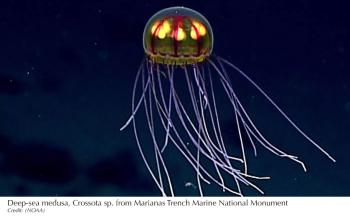
The deep sea is dark, mysterious and mostly unexplored. As technology improves scientists gain more resources to help reveal more and more about the largest habitat on earth. We consider ourselves very fortunate to live on Monterey Bay where the Monterey Bay Aquarium Research Institute (MBARI) is on the cutting edge of deep-sea research.
The deep sea differs from the ocean’s shallower depths in so many ways, primarily in three main areas: light, temperature and pressure. Light decreases with depth. At only 500 feet only 99% of light from the surface remains. Because of the lack of light, plankton that fuels the oceanic food web is limited to the surface waters. That sunlight warms the upper layers of the ocean, but the temperature drops quickly with depth and pressure increases. It’s unbelievable how animals adapt to all these conditions.
Adaptations
Finding food can be challenging in the dark. Many species make their own light, called bioluminescence, to attract prey. Anglerfish dangle bioluminescent lures to attract prey and the flashlight fish has a bioluminescent organ containing bacteria under its eye. The fish can shut off the light by closing a lid or withdrawing it into a pouch. They use the flashlight to attract prey, but also to communicate and evade predators. Some deep-sea fish also have specialized eyes, like the barreleye, which are light-sensitive and rotate upward when it’s looking for food overhead
Fish aren’t the only species to make their own light for feeding: some invertebrates do too, like this species of siphonophore that dangles red lures.
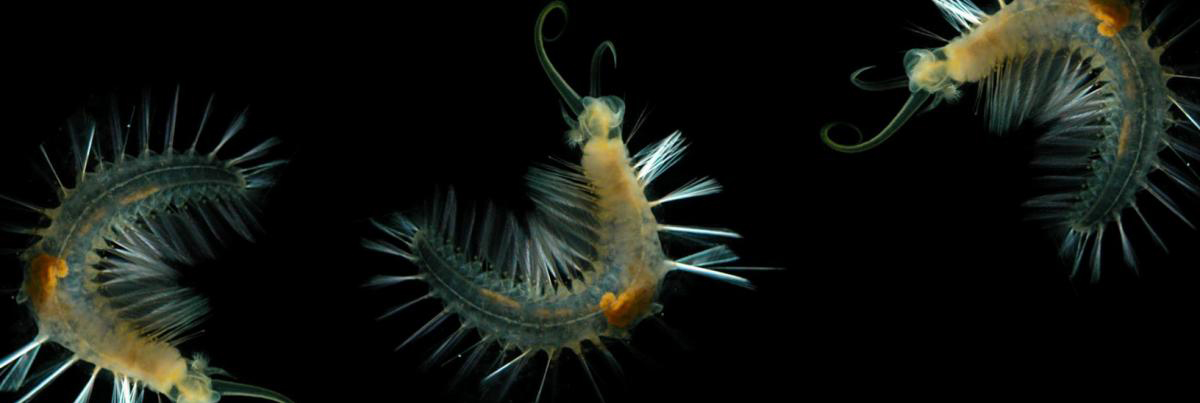
Deep-sea animals use bioluminescence for communicating, finding mates and evading predators. Scientists have discovered a variety of animals who use light to distract, startle or blind predators, like the green bomber worm and some jellies.
Plants form the basis of all food webs and in the ocean those plants are phytoplankton living only in surface waters. How do deep sea animals get food? Detritus (dead phytoplankton, poop, and other bits of organic matter) produced in surface waters drifts down to the depths as marine snow.
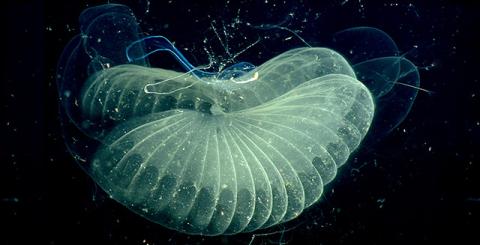
It’s Snowing Poop!
This marine snow is a major food source for many invertebrates. Larvaceans create mucus nets to trap marine snow drifting from above. A deep water octopus is adapted to harvest marine snow. Since large prey are few and far between, many deep sea fish have big mouths and hinged jaws that can expand to catch as big a meal as possible, like this gulper eel.
Cold water slows down processes. For example, a deep-sea octopus broods its eggs for five years; shallower species brood for two to 10 months. Many fish have soft bodies with bones containing less calcium to withstand the extreme pressures.
In many places, like here in Monterey Bay, there’s the added challenge of an oxygen minimum zone. At about 700 meters (2300 feet) the oxygen saturation drops to about 10% of that at the surface. The layer is about 150 meters (500 feet) deep after which the oxygen saturation rises again. Some animals live in this oxygen minimum zone because it’s a hiding place for predators like the jumbo squid Dosidicus. Unfortunately, due to climate change, oxygen in the oceans is declining and the oxygen minimum layer is expanding. What will this mean for animals adapted to the oxygen minimum layer?
The Largest Animal Migration on the Planet
The ocean is very deep and animals are adapted to live at different depths. Most animals don’t move from one zone to another except for those that migrate vertically. Many of the animals that live in the midwater zone make a daily migration from the deep to near the surface at night to feed on plankton. It happens across the globe and is considered the largest mass migration on the planet.
Animals make this dangerous daily migration at night to avoid visual predators near the surface. With the increasing light of dawn, krill, copepods (small crustaceans) and lanternfish all return to the depths where they are safer from predators. Some predators, like deep sea squid, follow the prey; other predators, like comb jellies and siphonophores, wait in the depths until morning when the prey species return.
Midwater Zone
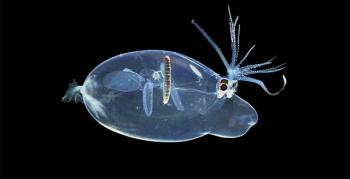
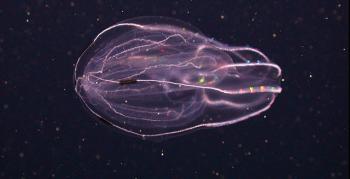
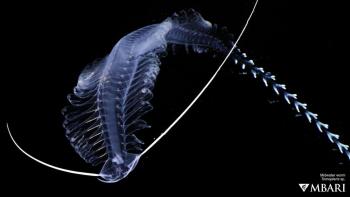
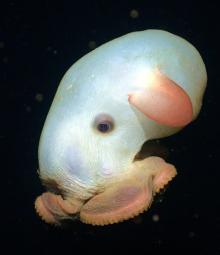
Tomopterid worm @MBARI Dumbo octopus Grimpoteuthis @MBARI
Lying between the ocean’s sunlit upper layers and the seafloor, the midwater zone is the largest habitat on Earth. It teems with life: fish, squid, jellies, siphonophores, crustaceans, tunicates, and worms all hunt and are hunted here. Scientists at MBARI estimate that three-quarters of the animals in this habitat are bioluminescent. Listen to Dr. Bruce Robison talk about the midwater
Benthic Zone or Deep Seafloor
The benthic zone is the bottom of the ocean. It’s dark all of the time and very cold with incredible pressure from the water above. The seafloor can be rocky or muddy. Some of the animals here live attached to sediment or rocks, others are free-swimming, while the smallest live within the sediment. Many of these animals depend on marine snow drifting down from above.
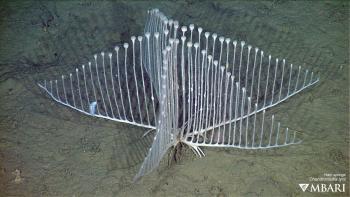
Harp Sponge Chondrocladia lyra
Sponges and sea fans attached to rocky reefs feed on the suspended food particles.
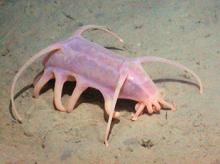
Sea cucumber Scotoplanes globose @MBARI
Others graze on the surface or burrow under it to eat organic matter. And of course there are predators including, fish, squid and octopuses.
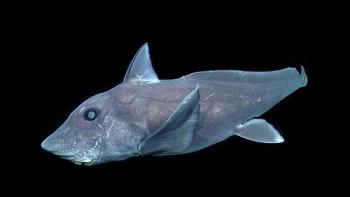
Chimaera Hydrolagus @MBARI
Chimaeras, deep-sea fishes, are opportunist feeders that prey mainly on bottom-dwelling invertebrates, such as crabs, molluscs, octopuses, marine worms, and sea-urchins. Like sharks, chimaera use electroreception to find their prey in the dark. These fish are little understood and threatened by overfishing and because they are caught as bycatch.
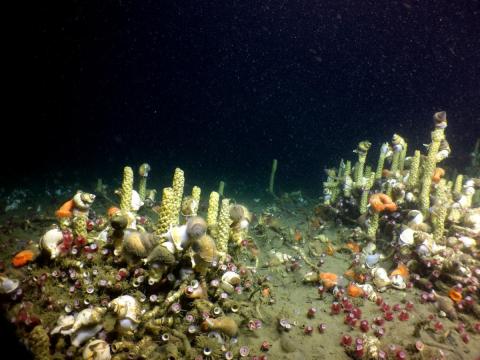
This image shows a mass of snails (gastropods called Neptunea) and their egg masses (the yellow towers) using clumps of tubeworms at a seep as a place to anchor them in the otherwise soft sediment of the deep. Image courtesy of Ocean Exploration Trust - Cruise NA095.
The Hot and Oozy Deep
A lot of the ocean is deep ooze as particles have been raining down for millions and millions of years. Not all the sea floor is uniform. In volcanically active parts of the ocean or where earth’s tectonic plates are moving, seawater deep in cracks within the earth is heated to extremely high temperatures—sometimes higher than 350C (660F). The hot water in these cracks or vents contains chemicals and sulfide minerals that spew out like geysers sometimes forming tall chimneys. Amazingly, there is a unique ecosystem with an abundance of life around these vents.
Hydrothermal vent animals depend on symbiotic bacteria inside their tissues that convert the hydrogen sulfide or hydrocarbons from the vent water into organic compounds for energy. The food web is based on this chemosynthesis instead of on photosynthesis like on land or shallow water.
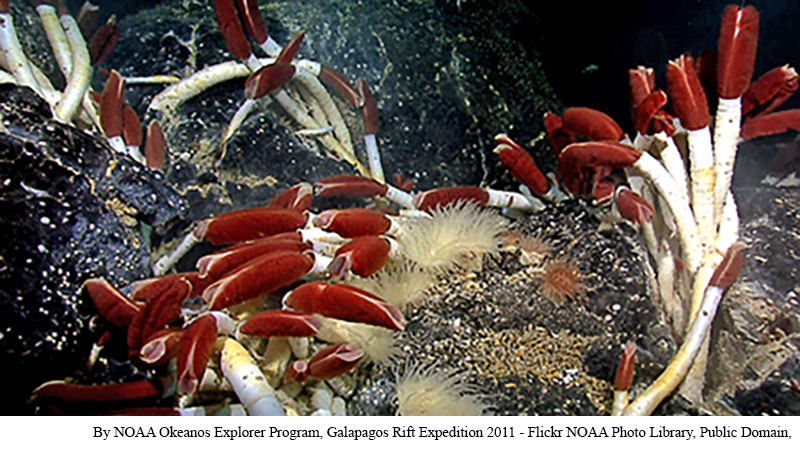
The charismatic animals at these vents are hydrothermal vent worms.
How Do We Get Into the Deep Sea?
The deep sea is vast and mainly unexplored. Originally, scientists had to use nets to sample what lives in the deep. The first technological innovations were Human Operated Vehicles, submersibles tethered to a ship where scientists can observe the deep. Now, scientists have even newer technology like Remotely Operated Vehicles (ROVs, tethered to a ship) and even vehicles that are not tethered to a ship – Autonomous Underwater Vehicles (AUV’s) equipped with still and video cameras, collecting arms, and sensors.
A Very Exciting Time to Discover the Unknown World
With all this new equipment, there is an abundance of scientific research going on around the world. Scientist inform us of all kinds of phenomena like the deep-sea food web, adaptations to the deep, chemistry and carbon transport. As of 2018, MBARI had discovered over 200 new species. There are more new species than formal descriptions at this point!
MBARI
Scientists at MBARI studying the deep sea for 30 years. You can see MBARI’s deep-sea highlights from 2020 here. And this is MBARI’s YouTube channel.
We have interviewed several scientists there some of which include:
Read more about scientific research into the deep sea
Good Introduction here
Watch this video about bioluminescence
Lesson Plans
MBARI
NOAA
Exploring the Gulf of Mexico’s Deep-Sea Ecosystems
Design a Deep-Sea Vertebrate or Invertebrate
The Feeding Ecology of Deep-Sea Fishes
















